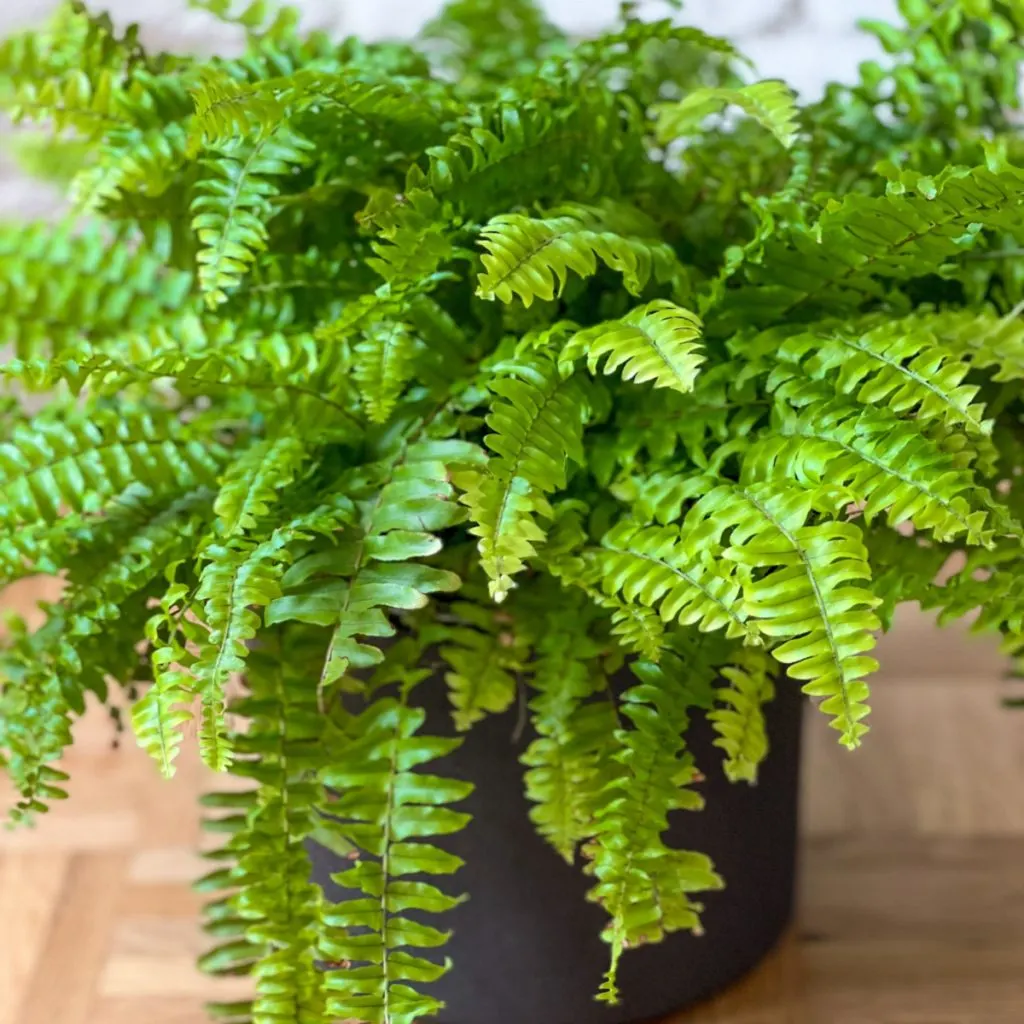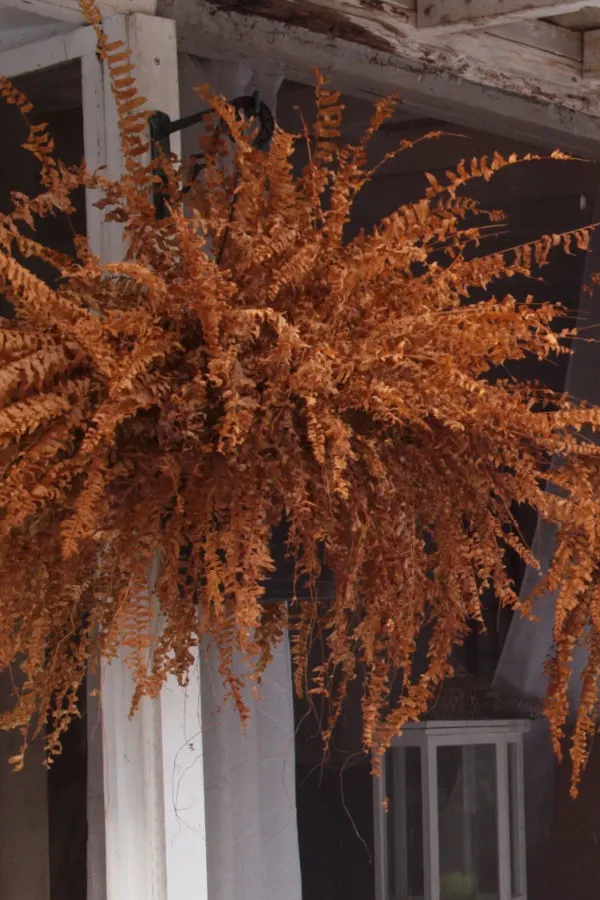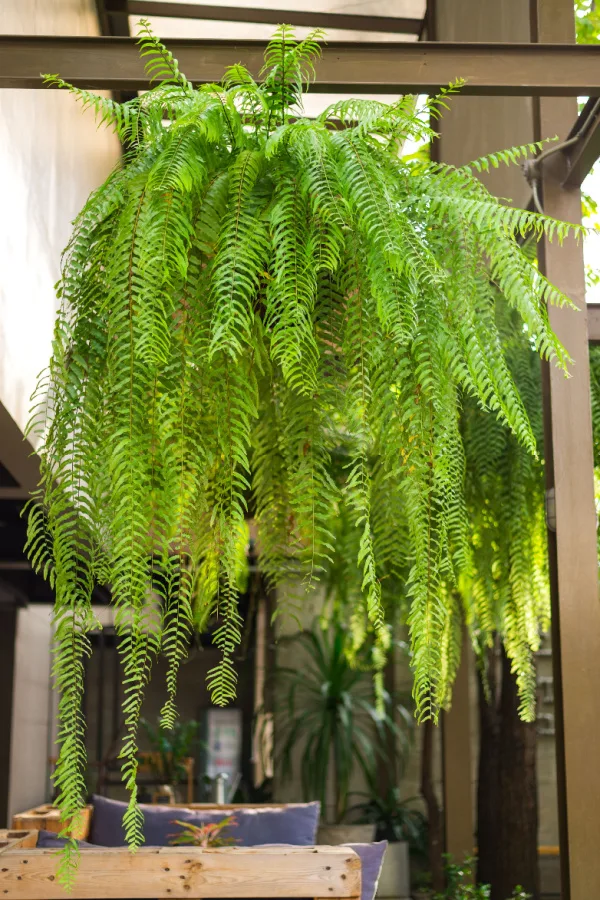Looking to bring your ferns indoors this fall and keep them alive as a houseplant all winter long?
Saving your ferns inside is not only simple and easy, but a great way to save big money on your gardening budget next year. Ferns are certainly great for decorating porches, patios and all kind of outdoor areas, but one thing is for sure, they can be quite costly to replace every spring.
Unfortunately, ferns are simply not tolerant enough to keep outdoors in climates that dip below the freezing mark. In fact, a hard frost or freeze can easily take out a fern in a single night. But although ferns can’t handle the cold winter months outdoors, they can and do overwinter extremely well indoors. And all with very little trouble and the slightest of care!

How To Keep Your Ferns Alive As A Houseplant
When it comes to successfully overwintering ferns, a few simple tips go a long way to ensure your plants stay healthy and strong. And the most important of all? Bring them inside before that first frost!
Ferns can be tolerant of cooler temperatures, but if they are left out through a frost, they injure easily. A frost can not only kill off a fern’s foliage, but stunt and damage its roots as well. And if it happens to be left out through a hard freeze? Well, it most likely will be heading to the compost bin and not to a second year of growth.
If an unexpected, early season frost or freeze is on the horizon, move your fern into a semi-protected place. A barn, shed or garage all work well. If that is not an option, at the very least, cover it with a blanket or sheet. The key is to protect it from damage until you can prepare it for indoor life.
Bringing Ferns Indoors For The Winter – How To Keep Your Ferns Alive As A Houseplant
Before bringing your fern inside, there are a couple of key steps you will want to take to get them in shape for indoor life. One is to prune and shape it back – and the other is to give it a good spray wash.

Warm, arid summer temps can cause massive growth for ferns. Before bringing it indoors, take a little time to shear back some of the excessive growth. A good pair of hedge shears is perfect for this task. Affiliate Link: GARTOL Garden Hedge Shears & Clippers, Manual Hedge Trimmer with Comfort Grip
There is no need for heavy pruning. Start by cutting back long stragglers that can make it difficult to place indoors. Finish by shaping up the plant with a light trim, making sure to cut back any fronds that will become an issue when sitting the plant on a stand or table.
Spraying Off Your Fern – How To Keep Your Ferns Alive As A Houseplant
The easiest way to spray your plant down is with a garden hose. Thoroughly spray the entire foliage everywhere. When spraying, lift the fronds up to hit the underside of the leaves as well.
This is absolutely vital to remove any and all insects and pests that may be living in your plant. Remember that your fern has been outdoors all summer. And because of that – everything from moths, spiders and aphids – to even a bird’s nest might be lurking within its foliage.
Not only will spraying them down keep out unwelcome house guests, but it will also help hydrate the plant as well. Allow the plant to completely dry off and then it’s ready to bring indoors. That is – if it can still fit in its container!

Repotting Ferns That Are Root Bound – How To Keep Your Ferns Alive As A Houseplant
Many ferns will need to be repotted before they can come inside. When a potted plant becomes overloaded with roots, it can make watering a touch chore. Ferns are no different and can suffer quickly from being root bound.
Inspect the pot of your fern to see if its roots have filled the entire space. If there is little soil left or the roots have completely surrounded the sides of the pot, it is time to take action. Another great indicator that your fern may have too much root growth is if it simply can’t hold water. If you water and it runs right through – your plant is root bound!
Although you can divide and split the fern into new plants, fall is not the best time to do this. Instead, it’s better to simply give your fern a little more space and soil in a new pot and keep it as a houseplant, then when spring rolls around, you can divide it into smaller plants.
A good rule of thumb is to replant ferns in a new pot that is one-quarter to one-third larger than its previous container. Use a high-quality, light potting soil when re-potting. Resist the temptation to give ferns too much new space. See: The Perfect Potting Soil Recipe – Made With Just 5 Simple Ingredients!

Left in pots with too much soil surrounding its roots, a fern will become over-saturated. The excess soil simply retains too much moisture and the plant will struggle. There is no need to fertilize at all. Ferns do not require much to perform well. In fact, too many nutrients will cause more issues to a fern than not enough.
Giving Your Fern The Best Location Indoors – How To Keep Your Ferns Alive As A Houseplant
Now your plants are ready for the indoors! To survive, ferns do not need full sun or maximum lighting through the winter months. A location that is overly sunny will actually cause a fern more harm than good.
Ferns perform best in moderate, indirect lighting conditions. This can be in a cool basement with indirect lighting from a basement well-widow, or in the corner of a room that receives natural light from a nearby window.
One thing you want to do is keep your fern away from a southern facing window. The sun’s heat and rays coming in through the glass can actually burn foliage. Windows that do not face the south can work well for ferns, but again, indirect lighting a bit away from any window is the best choice of all. In addition, keep them out of the direct path of heating vents.
Water your ferns through the winter only when the soil completely dries out. Ferns suffer more from over-watering than under-watering. If your ferns takes on a little less color or loses a few leaves in the winter, there is no cause for panic. They will return to full glory in the spring.
As spring comes back around, start to take plants out when the weather begins to warm. Just as in the fall, be sure to protect your ferns from late spring frosts or freezes. Here is to keeping your ferns alive this fall and winter – as a houseplant! For more tips on keeping ferns healthy & thriving, you can check out our article: What To Do With Overgrown Ferns In The Summer – How To Save Your Fern!
This Is My Garden
Follow Our Facebook Page For Great Gardening Tips And Advice! This Is My Garden Facebook Page
This Is My Garden is a garden website created by gardeners, for gardeners. Jim and Mary Competti have been writing gardening, DIY and recipe articles and books and speaking for over 15 years from their 46 acre Ohio farm. They publish three articles every week, 52 weeks a year. Sign up today to follow via email, or follow along!
